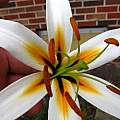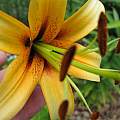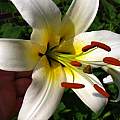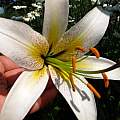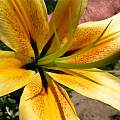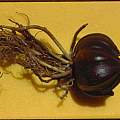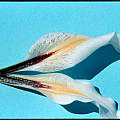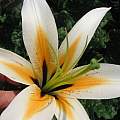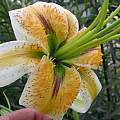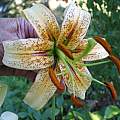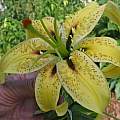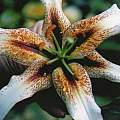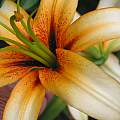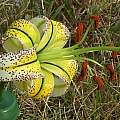Lilium ×aurelianense (Lilium henryi × Lilium sargentiae) was bred by Edouard Debras in France. Carlton Yerex invented the name "Aurelian hybrids" for plants originating from L. ×aurelianense with L. henryi characteristics. This term is now used for all hybrids between Chinese trumpet species and L. henryi. The name "aurelianense", means "from Orléans" , Orléans being near where Debras lived and grew lilies. The old Roman name for Orléans was Aurelianum or Aureliana Civitas; Aurelian was a Roman emperor (270–275 AD) and the town was named for him. In Latin aurum means golden.
This page contains two short descriptions of the history of a particular trait in Aurelian hybrids the first by Rimmer de Vries and the second by Charlie Kroell.
The first black heart aurelian to gain recognition was Leslie Woodriff's 'Black Heart White' hybridized in the late 1950s. Black hearts or black nectaries are the result of red over the deep green coloring of the nectary.
The source of the black heart coloring is not fully understood but many of the Lilium rosthornii bulbs from Chen Yi displayed black hearts of some degree so there is a suspicion that the black or dark nectaries may be from L. rosthornii; however, L. rosthrornii was not known (or had not been separated from L. henryi until about the 1980-90s). (L. rosthornii can be easily distinguished from L. henryi by the foliage, height, bloom time, and seed pod - L. rosthornii being much shorter 2-3 feet vs. 4-6 feet in L. henryi. L rosthornii has very narrow leaves on the order of half as wide as L. henryi leaves, blooms a month later than L. henryi and L rosthornii has 1.5 cm 1/2 inch wide (thin) seed pods full of tiny seed about 1/4 the size of L. henryi seed whereas L. henryi has fat stout seed pods to make room for the large seed.
Some notable black hearts (all predate the introduction of L. rosthornii) Leslie Woodriff's 'Black Heart White', Charlie Kroell's 'Susan Elizabeth' (named for his grand daughter) and 'Bill's Black Heart Trumpet' (from the late Bill Craig of Battle Creek, MI).
Jeffrey Boden in Australia, Anton Mego in Slovakia and Pete Shieman at S-W Gardens in Ontario are working extensively on breeding black hearts. Red hearts are of similar interest - Brian Bergman of Ontario and Charlie Kroell of Michigan are working on red heart breeding (see March 2013 NALS QB). More photos and information about L. rosthornii can be found here.
Photographs by Rimmer de Vries.
Photographs by Charlie Kroell of Leslie Woodriff's 'Black Heart White'.
"Black hearts" have been a fascination of mine since 1973 when I saw a bloom of Woodriff's 'Black Heart White' for the first time, and I've been playing around with them pretty much ever since. There's a broad spectrum of appearance, involving color ("black," near black, chocolate, mahogany, red...whatever descriptor the eye of the beholder may deem most appropriate); size (long, short, narrow, wide...); blending, through "penciling" or "brushing," with a normally green nectary; and intensity or "saturation" of the coloring. Below there is an image of an old seedling (unfortunately no longer with me) that demonstrates, to a degree, how conspicuous the trait can be. black hearts certainly aren't everyone's cup of tea and although generally striking, may not be looked upon as "beautiful." But I and many others are very fond of them.
The origin of the trait is uncertain. As Rimmer has indicated above, the earliest record is that of Woodriff. His 'Black Heart White' (unregistered at the time) is listed in the ILR as a pre-1960 cross: 'T.A. Havemeyer' × 'White Henryi', i.e. (Lilium sulphureum × L. henryi) × (L. henryi × Lilium leucanthum var. centifolium), with L. henryi being represented in each of the parents.
Dr. Robert Griesbach (Professor emeritus, DePaul University, Chicago) has noted that in the case of species hybrids, spontaneously appearing phenotypic traits within the progeny (such as black nectaries, brushmarks, 'spreckles', etc.) do not necessarily relate back to the phenotypes of the parental species and that different metabolic pathways in the species parents can lead to qualitative differences unique to the hybrid progeny, so that it is not surprising that one picks up new traits that cannot be traced back to the species progenitors.
Actually, in the same time frame as Woodriff, Darby, in England, reported the appearance of dark nectaried seedlings among his Aurelian hybrids [Darby, G.W. 1962. "A Mutation in Aurelian Hybrids." The Lily Yearbook, London: The Royal Horticultural Society]. There have been other reports as well. Clearly, L. rosthornii can display "black" nectaries (Kühne, H. and N. Martschinke. 2000. "Lilium rosthornii: Variation of Characteristics." The Lily Yearbook, NALS, p. 22; photographs p. XVIII. See also Mathew, B. 2002, "Two interesting lily introductions" LILIES and Related Plants, RHS Lily Group, p. 25 [see also p. 27, 29]); but my personal opinion is that (at least the great majority of) the Div. 6 black-hearted hybrids that we see today most likely derive from L. henryi.
Photographs by Charlie Kroell. The last is of Lilium taliense var. kaichen showing the black nectary grooves.
American Section A-M - American Section N-Z - Asiatic Section A-C - Asiatic Section D-K - Asiatic Section L-O - Asiatic Section P-Z - Candidum Section - Dauricum Section - Martagon Section - Oriental Section - Trumpet Section - Lilium Hybrids - Lilium index

